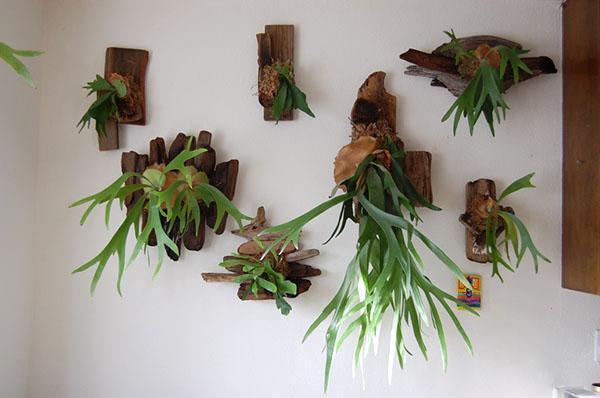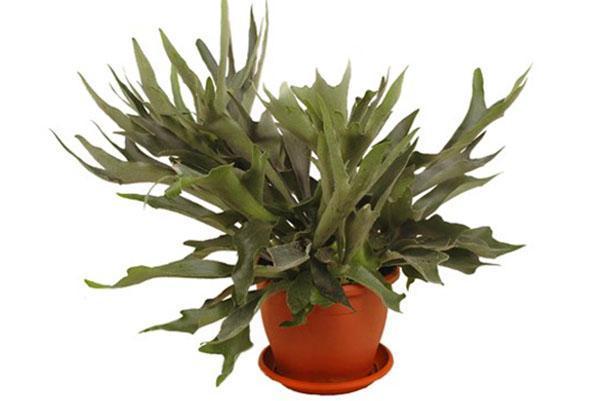Unusual Platitzerium fern at home
 Despite the fact that it is enough to simply keep the Platitzerium at home, fern cultivation not all growers are ready to deal with it. In order for the plant to feel as comfortable as possible, it is necessary to adhere to certain lighting, watering regime and air humidity.
Despite the fact that it is enough to simply keep the Platitzerium at home, fern cultivation not all growers are ready to deal with it. In order for the plant to feel as comfortable as possible, it is necessary to adhere to certain lighting, watering regime and air humidity.
Description of the plant

Due to its unique appearance, the fern got such a name, which is translated from Greek as “flat horn”. In popular use, you can also find the names "deer antlers" or "flathorn".
 The genus includes about 18 species. These are rather large plants that grow not on the ground, but on a woody substrate (stumps, branches, trunks). The main distinguishing feature of the Platycerium is the presence of two types of leaves:
The genus includes about 18 species. These are rather large plants that grow not on the ground, but on a woody substrate (stumps, branches, trunks). The main distinguishing feature of the Platycerium is the presence of two types of leaves:
- the first of them bear spores and outwardly resemble horns;
- the second leaves are absolutely sterile, flat, and their main task is to fix the plant on the substrate and create a favorable environment for it.
Keeping a platycerium at home, growing and caring for it requires certain knowledge and skills.
Features of home care
 Since Platycerium belongs to tropical plants, then the conditions are required as close to natural as possible.
Since Platycerium belongs to tropical plants, then the conditions are required as close to natural as possible.
Lighting. Platiterium belongs to light-loving plants that need sufficiently bright lighting. In shady areas, it stops growing, forms spores, and eventually dies. But, at the same time, and direct rays act on him adversely, forming numerous burns. Therefore, it is best to place the plant in the eastern or western part of the house. The degree of illumination depends on the shape and size of the leaves: the narrower and smaller the leaves, the more light is required for the plant.
The temperature of the content of the platycerium. For the comfortable existence of the fern, the temperature should fluctuate within + 18-22 ° C. If the temperature rises above + 22-23 ° C, then the humidity must be increased. In the summer, Platitzerium can feel comfortable at temperatures up to +30 ° C.
The plant does not tolerate too dry air poorly, therefore Platiterium should not be placed next to heating and heating devices. Drafts should also be avoided.
Irrigation mode for the Platitzerium. The fern requires constant, moderate watering. It is important to keep the soil moist, but not wet. In the hot season, once a week, you can leave the pot with the plant in a basin or bath of water. This procedure should take about 3-4 hours.
 High humidity is also required. It is recommended to frequently spray the plant and the air around it.
High humidity is also required. It is recommended to frequently spray the plant and the air around it.
Do not wipe the leaves and leave drops of water on them, this greatly damages the hairs on the surface of the leaf plate.
Reproduction and transplantation
 Platizerium transplant is carried out in early spring every 1-2 years. When transplanting, the plant should not be deeply buried in the substrate, and you should also monitor the safety and integrity of the roots.
Platizerium transplant is carried out in early spring every 1-2 years. When transplanting, the plant should not be deeply buried in the substrate, and you should also monitor the safety and integrity of the roots.
The soil should be chosen with a slightly acidic reaction, rather loose. For this purpose, a ready-made soil mixture is suitable, to which you need to additionally add peat, sphagnum and pine bark. For a platycerium, a drainage is a prerequisite.
So how to grow platycerium? Reproduction can be done in two ways:
- With the help of "kids". For this, a process with 3-4 leaves is separated from an adult plant, which must necessarily have a small rhizome and a bud. It is then placed in a small pot of loose earth.
- Disputes. The method is rather difficult and is not very popular among flower growers. For this, spores are collected from an adult plant more than 5 years old, and then they are sown in a sufficiently moist soil (a mixture of sphagnum and sterilized peat). The height of the substrate layer should be low. The container with spores is covered with glass and a microclimate is created.
Sometimes, due to the laboriousness and complexity of reproduction of Platyceria, it is much easier to buy a new young plant.
Disease and pest control
 For the normal growth and development of the plant, it is important to protect the Platycerium. Diseases and pests cause slow growth, discoloration of leaves and plant wilting.
For the normal growth and development of the plant, it is important to protect the Platycerium. Diseases and pests cause slow growth, discoloration of leaves and plant wilting.
Among the most common diseases of the platycerium are:
- the appearance of brown spots on the leaves: you need to move the plant to a cooler place and humidify the air;
- fading and lethargy of leaves: you need to remove the fern in a shaded place;
- slow plant growth: transplanting into a deeper and wider pot is needed;
- the leaves have acquired a brown tint: more frequent watering and abundant spraying are needed;
 Platycerium pests include aphids, scale insects, spider mites and thrips. It is best to collect insects by hand, or in extreme cases with Fitoverm or Actellik insecticides.
Platycerium pests include aphids, scale insects, spider mites and thrips. It is best to collect insects by hand, or in extreme cases with Fitoverm or Actellik insecticides.
It is not recommended to use pest control chemicals often and in large quantities, otherwise it will lead to burns and deformation of the leaves.
Growing platycerium at home requires a number of conditions and special care. But the spectacularity and uniqueness of this fern pays off the time and effort spent.